A Practical Guide for Product Strategy From Almundo: A Case Study: [Mind the Product]

Eighteen months ago travel tech company Almundo started to refine its processes to become a product-driven company. Our goal was to define how we would set and communicate the company strategy, and how that strategy would lead OKRs and backlog definition. This is what we did.
Note: This post was written before the Covid19 lockdown. We are currently rethinking the process to be 100% remote-friendly. Stay safe.
Product (and company) strategy is the backbone that guides product goal-setting and roadmap definition, although it’s sometimes overlooked or confused with having a vision. Without it, product teams become feature teams focused on outputs and not outcomes.
The Approach (the Frameworks)
We started working with the product teams on how each tool – product strategy, OKRs, and roadmaps – should be used so that we could merge them together.
OKRs serve to answer where we want to go (the objective) and how we pace ourselves to see if we’re getting there (key results). They are a marvelous and simple tool to help teams to focus on key outcomes, prioritize work, and communicate results.
Some of the best-known resources on the subject include the books Radical Focus by Christina Wodtke, Measure What Matters by John Doerr, and reWork and Google’s guide on setting goals with OKRs.
Andrew Grove explained his methodology of “management by objectives” (MBO) in his book High Output Management in 1983: “The idea behind MBO is extremely simple: If you don’t know where you’re going, you’ll not get there. MBO is largely designed to provide feedback relevant to the specific task at hand; it should tell us how we are doing so we can make adjustment in whatever we are doing if need be. The one thing an MBO system should provide par excellence is focus. A few extremely well-chosen objectives impart a clear message about what we say ‘yes’ to and what we say ‘no’ to.”
We experimented for several quarters till we got an OKR format to suits our needs. We needed something transparent, easy to complete, and with focus: no more than three objectives, with no more than three key results each, shared across the organization, on a Google spreadsheet.
Product roadmaps are essential tools for assessing opportunities and defining how we accomplish our objectives. As C. Todd Lombardo said, a roadmap is more about communicating your product strategy than it is about fixing features and dates. It is a statement of intent and direction – a compass, a destination, with options for a path to get there – complementary to OKRs.

Our focus was on clarity and simplicity. After trying complex Gantt charts and even product backlog software, we opted for a single slide on a Google presentation to show the roadmap and its execution. This approach helped us to communicate to upper management that the roadmap was fluid, and the ‘lack of formality’ gave teams the confidence to commit in defining what epics to tackle each quarter.
What aligned roadmaps and OKRs together was the product strategy. It is the guiding principle for OKRs and roadmaps. As defined by Alan Lafley and Roger Martin in their brilliant book “Playing to win”, a strategy is the coordinated and integrated set of five choices:
- What is your winning aspiration? What is the purpose of your enterprise, the “why” in Simon Sinek’s golden circle?
- Where will you play? Where will you compete: which customer segments, which categories, which channels? I believe that not having focus is one of the main reasons why products fail.
- How will you win? What is or will be your competitive advantage? Will you follow Porter’s path for differentiation or cost leadership?
- What capabilities must be in place? Do you have the skills and resources to see it through?
- What management systems are required? What processes and mechanisms are needed to support the choices?
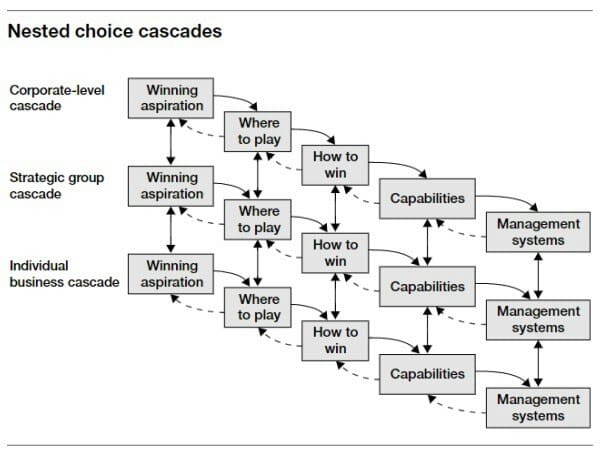
I’d like to share next how we merged these frameworks together in a unified process.
Our Three Stepped-Process
1. Defining the North Star: A Full-day Workshop
Corporate-Level Choice Cascade
The process starts top-down. The leadership teams gather before each quarter ends to review the company vision and revise the strategy.
This is an important step, but it’s often omitted. As the Chinese general Sun Tzu said, tactics without strategy is the noise before defeat. Without focus, the teams can’t be outcome-oriented. Without the proper boundaries, bottom-up goals and initiatives can’t emerge since the scope is too broad to cope with.
A product strategy is meant to describe the vision of what you are trying to accomplish. Usually, the timeframe is between two and five years out. It is a visionary work and meant to be persuasive. It is definitely not a spec in any sense. Product Strategy in an Agile World Marty Cagan
We start the workshop morning with the leadership team sharing business context and direction. Their presentation ends with a Q&A session to clarify any uncertainty. Transparency is paramount for autonomous and agile teams.
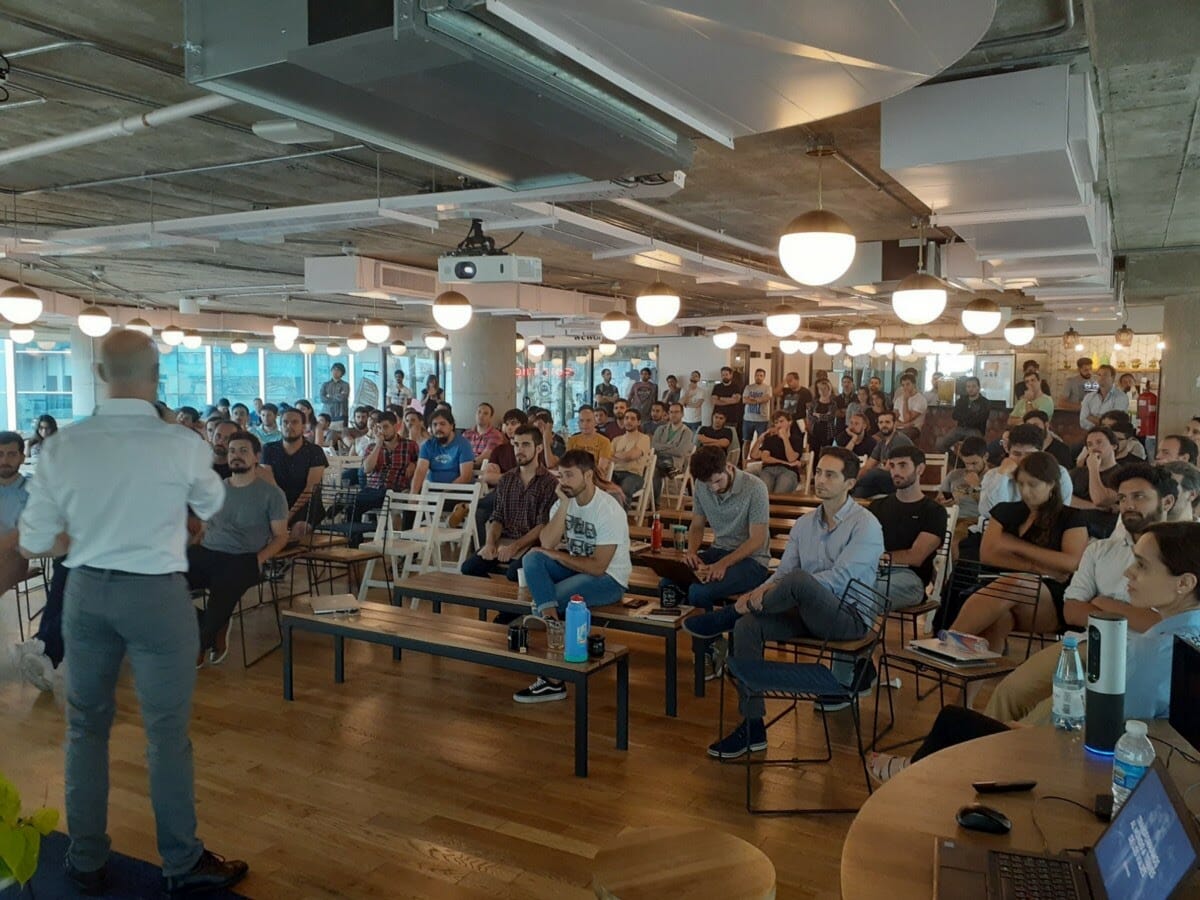
In our case, we were recently bought by Brazil’s CVC Corp, the biggest travel company in Latin America. An article published by travel industry news outlet Skift commented: “More importantly, the Almundo acquisition will provide CVC with the ‘omnichannel’ sales platform the company has been developing for years. Almundo CEO, Juan Pablo Lafosse, told Skift that Almundo is a ‘key piece in this transformation’ of CVC to become more digitally focused, and that the two companies are highly complementary.
Business-Level Choice Cascade
Once the corporate-level choices are understood, the process can cascade to lower levels, leaving the business units and teams to decide which choices can support higher-level goals.
After usually a keynote from an outside speaker (and lunch), each business unit gathers together for a deep dive into their strategy. We start by reviewing each quarter a different framework to re-think our decisions and get ideas flowing. Some methodologies we have used are:
- Strategy Canvas (‘Blue Ocean Strategy’ by Renée Mauborgne and W. Chan Kim): this process consists of capturing the main competitive factors for the industry and the satisfaction levels that competitors deliver on these factors. Then, we use the four actions framework to analyze which factors are served or fulfilled beyond customer demands, and where the customer expects better service and we have an opportunity to create a new value curve.
- User Story Mapping (check the book by Jeff Patton): this is helpful to create a full picture of how a product is used. Creating a story map is always an enlightening activity since it forces you to think about the complete customer experience. With the journey visually displayed, we can clearly see the pain points and opportunities to enhance our strategic decisions.
- Business Model Canvas (by Alexander Osterwalder, of Strategyzer): The business model canvas is a great tool to help the teams think of their goals, resources, and stakeholders in a straightforward, structured way
- Hands-on games like Design the Box: the goal is to create a physical “box” that sells the product strategy. By imagining the box, the teams make decisions about differentiation features, the target customer, and other aspects of their vision that are more difficult to articulate.
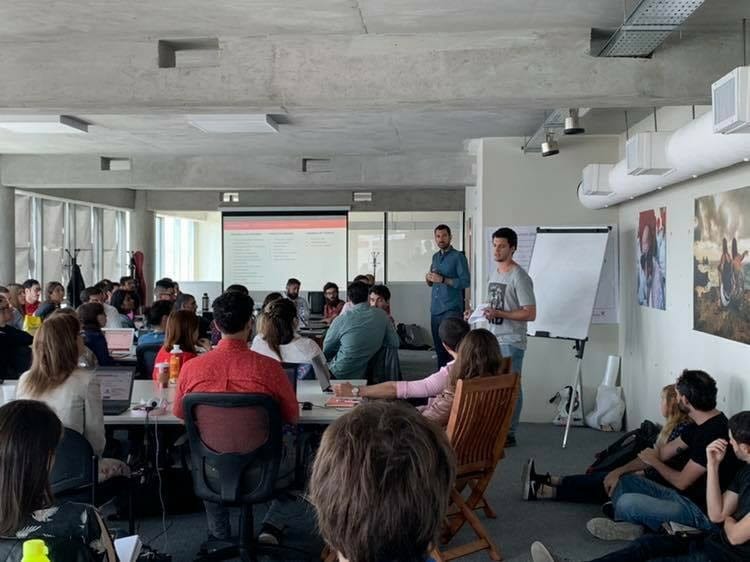
After this creativity-boosting activity, we then try to agree on the first draft of OKRs. These objectives and key results should measure effectively if they are moving towards their strategic goals.
Additionally, teams should be able to name the main themes/epics, pain points or development opportunities that should be tackled to succeed.
OKRs and Backlog Draft
The day ends with an activity called “World Café”. The methodology is quite simple, it consists of 20-minute rounds of group discussion at tables followed by a group synthesis.
Since we have a lot of product teams, we fix product vertical teams like Flights, Hotels, or Packages at one table and have cross-functional teams like the Marketing, Checkout or After-sales rotate from table to table. This means teams have a chance to go ‘around the world’ and bring their ideas with them from table to table.

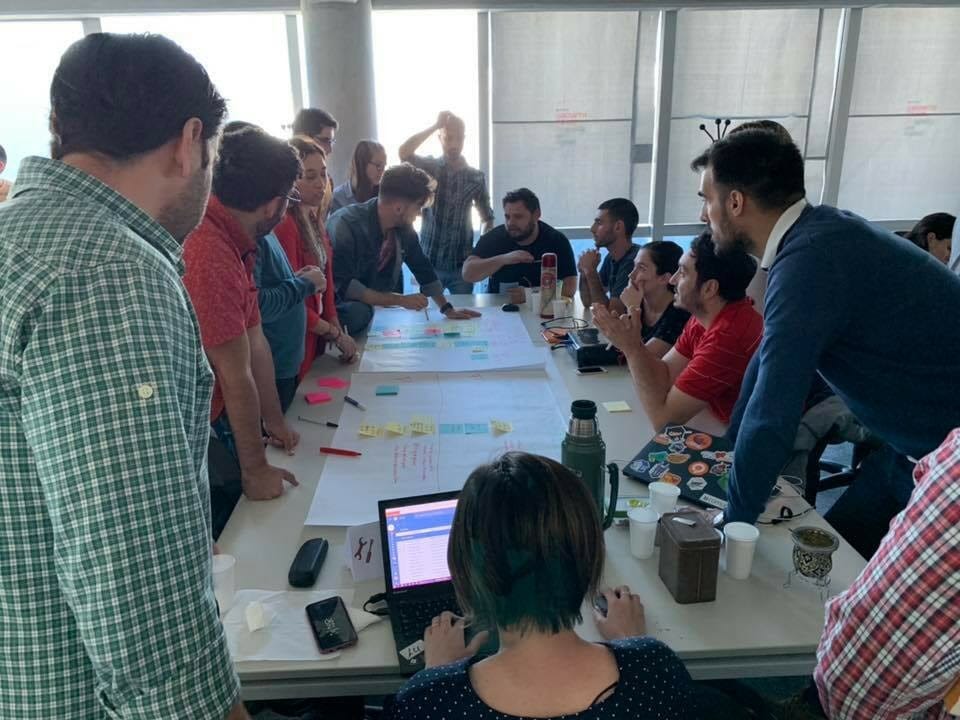
It means that teams have a chance to go “around the world” and take their ideas from table to table. The goal is to end the rounds with a good understanding of the other teams’ main epics and objectives. Similarly a team should get a clear view of the expectations from others of their own team.
2. Prioritization and Definition
During the following two weeks, each team will get together, reflect on all insights gathered during the World Café, and make their best effort to define the “final” backlog and OKRs.
Although we don’t have a defined framework for prioritization, most teams use the RICE approach (reach, impact, confidence, and effort) trying to estimate impact and effort but adding confidence to the equation.
When the work is done, every product manager validates the outcome with their main stakeholders. If you don’t know who they are or the best strategy to engage them you can even perform a Stakeholder Mapping activity. Managing expectations, handling multiple conflicting requests and communicating product strategy are key skills of a product manager. This is a vital step to have everyone on board and reduce the likelihood of completely modifying the intended roadmap and stressing the team.
The end result is shared across the organization using Google Sheets for OKRs and Google Slides presentation for roadmap communication (I’m not a big fan of fancy product roadmap software). Here’s an example of both deliverables:
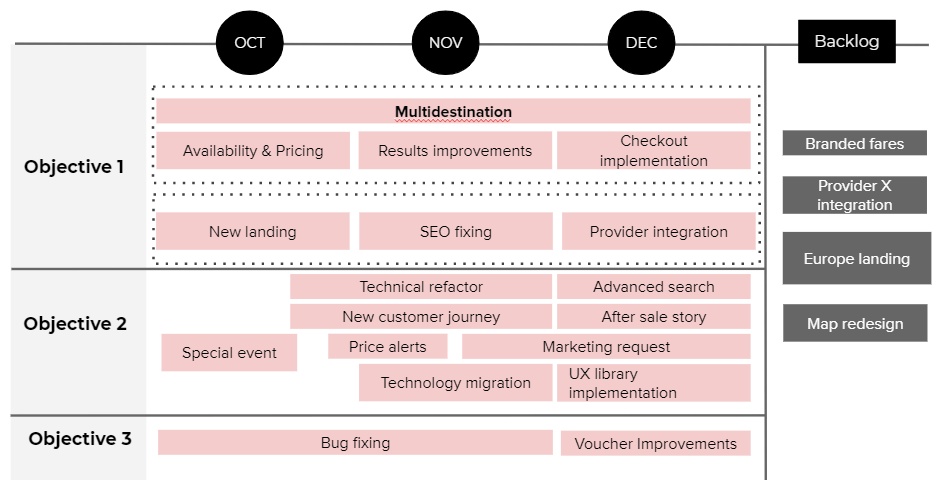

3. Quarterly Meeting and Planning Day
Lastly and as the new quarter begins, we share all the work done on our planning day. This is not an exclusive product gathering, but a whole leadership team meeting.
This is our most important gathering whose goal is to:
- Bring alignment and discuss around vision and strategy
- Celebrate achievements and outstanding contributors
- Share business updates and results of the previous quarter
- Present the OKRs and roadmaps for the following period
On top of the presentations and hard work, the quarterly meeting is a great opportunity for fun and team-building (any resemblance between rafting and getting the product backlog through corporate processes is purely coincidental).
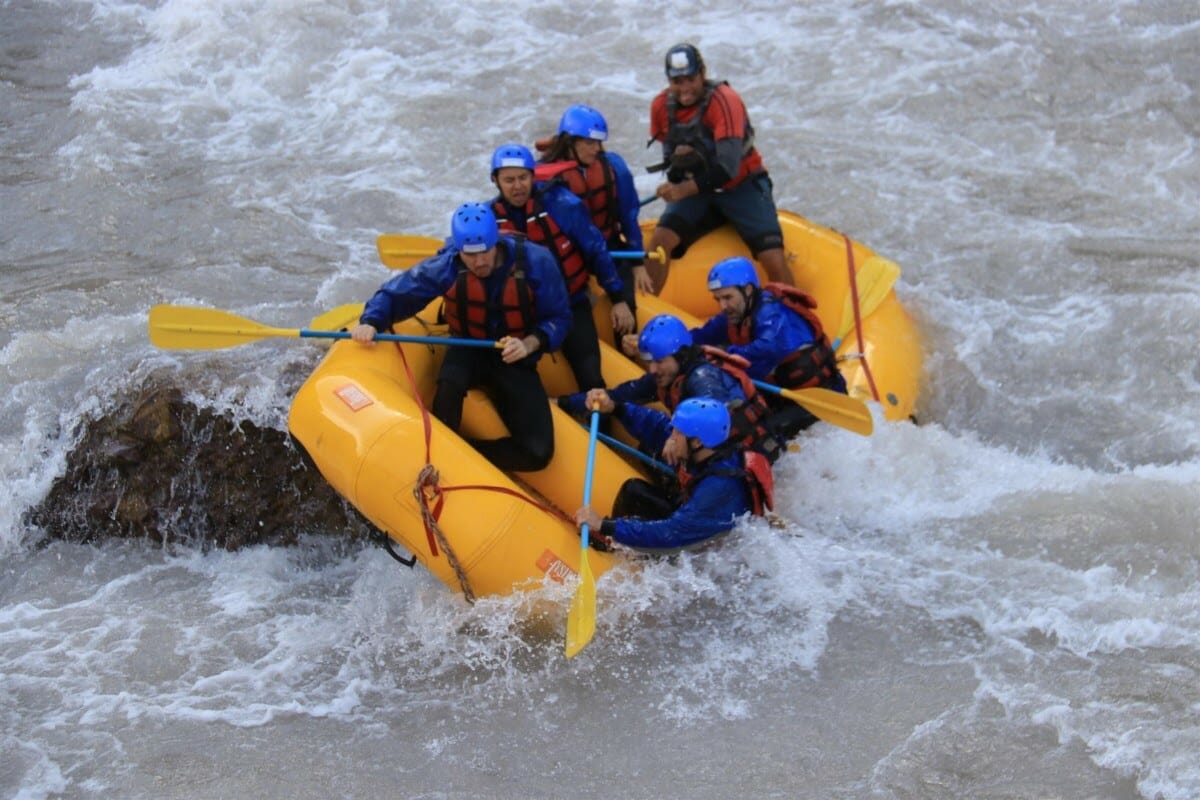
Takeaways
We iterate and set a framework to integrate mid-term planning, OKRs setting, and backlog prioritization. Summing up, the quarterly product strategy is defined by a three-step process:
- Company vision and goals are clearly defined and shared within the organization. Business units use the strategic choice cascade to align their choices with the upper-level strategy.
- We use world café methodology to incentivize backlog discussion, identify dependencies and ‘cross-pollinate’ ideas and insights across the area. Each team then prioritizes, sets and aligns with its main stakeholders their quarterly roadmap and OKRs.
- The process outcome, along with previous quarter results, is shared on a leadership team full-day meeting.
Reference and Inspiration
- What is strategy – Michael Porter
- Playing to win – Alan Lafley and Roger Martin
- The World Café: Shaping Our Futures Through Conversations That Matter – Juanita Brown and David Isaacs
- Radical Focus – Christina Wodtke
- Measure What Matters – John Doerr
- Blue Ocean Strategy – W. Chan Kim, Renée Mauborgne
- Business Model Canvas – Alexander Osterwalder
- User Story Mapping – Jeff Patton
- Escape from the feature roadmap to outcome driven roadmap – Mind the Product
- Roadmaps are Dead! Long Live Roadmaps! – C Todd Lombardo on Mind the Product
The post A Practical Guide for Product Strategy From Almundo: A Case Study: appeared first on Mind the Product.
Source: Mind the Product https://www.mindtheproduct.com/a-practical-guide-for-product-strategy-from-almundo-a-case-study/

Post a Comment